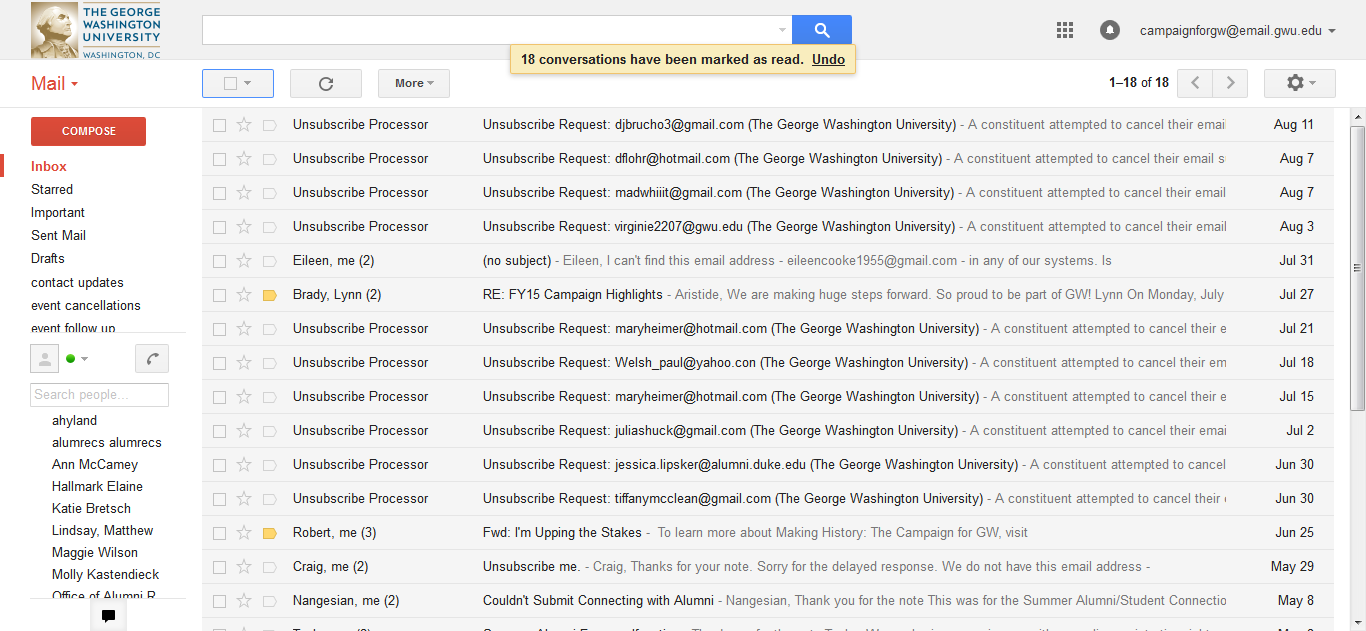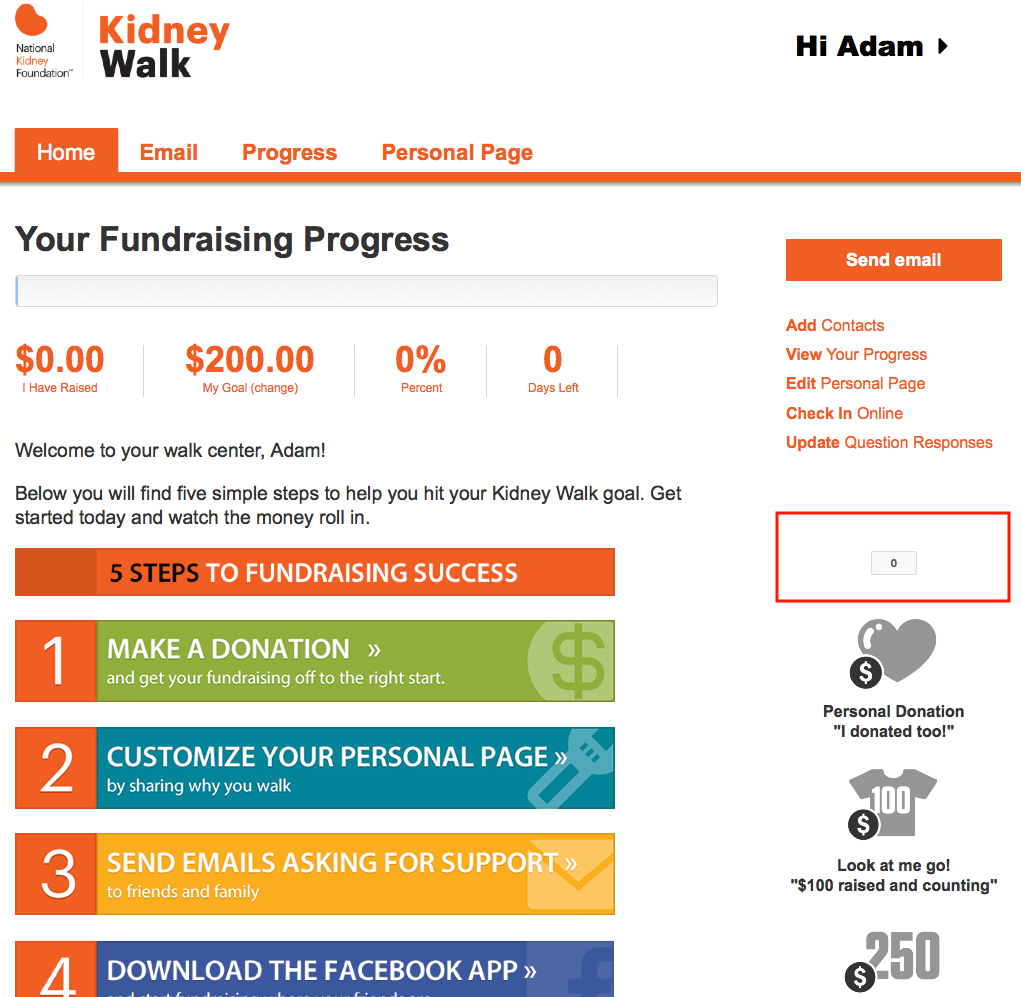Luminate and Google's Universal Analytics
A client asked me today about the weird intersection of Google's new Universal Analytics, the problem of cross-domain tracking and the Luminate product.
I wrote up an explainer that covers many of the questions you might have here: http://www.safdaranalytics.com/2014/04/blackbaud-convio-luminate-and-google-universal-analytics/
I'm pasting it below, and will happily answer non-client-specific questions about this topic here.
-Shabbir Imber Safdar,
Chief Data Whisperer
Blackbaud (Convio) Luminate and Google Universal Analytics
I recently was speaking to a client who uses Blackbaud/Convio Luminate about their Google Analytics install and the topic of Google’s new Universal Analytics came up. Do you need to upgrade to UA? Will you have to? How will it affect your installation and cross-domain tracking, and if you’re using the Google Analytics code that’s generated by the Luminate product, is that “Universal Analytics” compatible?
What is Universal Analytics?
Universal Analytics is Google’s next iteration of analytics tracking in the Google Analytics product. It is a giant improvement in how tracking is done. It allows you to track a participant across multiple devices and multiple screens, and lets you create all sorts of custom dimensions so you can track the behavior of different classes of visitors. A simple example of this would be a custom dimension that let you track visitors who were members vs. those who were not.
It is not optional in the long run. Eventually everyone will have to use UA and as the Dr. Who Cybermen say, “You will be upgraded.”
What is cross-domain tracking?
Because almost all Luminate clients have their donation forms on a different domain name (secure*.convio.net) than their website (www.awesomenonprofit.org), when someone goes to donate they jump domains. This is typically not a big deal, as the web pages look the same even though the address bar shows a different domain name in the URL. However analytics tracking is based on cookies, and cookies most definitely are not allowed to belong to more than one domain. The upshot of this is that you lose all that juicy analytics data when the donor clicks on the Convio-hosted donation form and jumps domains.
This is a problem because you often want to work backwards from a completed donation to figure out which one of your 37 marketing efforts drove that person to give. Was it your media coverage of something you did? Was it Facebook posting? Was it from Twitter? Did someone watch your YouTube video and then, motivated to give, come and give you money? Any time you jump across domains you lose all that juicy tracking info because the user gets a new cookie.
People have to create a slightly altered installation of Google Analytics in order to track users as they jump domains and not lose that valuable tracking information.
Does Universal Analytics make cross-domain tracking easier?
Oh yes. Here’s a snippet of code that would go on your main nonprofit website:
ga(‘create’, ‘UA-XXXXXXXXX’, ‘auto’);
ga(‘send’, ‘pageview’);
//Load the autolinker plugin
ga(‘require’, ‘linker’);
//define autolinking domains
ga(‘linker:autoLink’, ['secureX.convio.net']);
And here’s a snippet that would go in the pagewrappers of your donation forms on secure*.convio.net:
ga(‘create’, ‘UA-XXXXXXXXXX’, { ‘allowLinker’: true });
ga(‘send’, ‘pageview’);
Along with the main Javascript function that includes the analytics.js snippet, that’s all there is to it. Suddenly I’m happily out of a job implementing cross-domain tracking. However, Luminate does not yet speak Universal Analytics. and since all domains have to be using Universal Analytics code together, you can’t really use this yet if you use Luminate’s Google Analytics integration on your donation pages.
What is Luminate’s Google Analytics integration and do I really need it?
Luminate has some special hooks that allow you to capture donations and purchases in their product and feed them into Google Analytics E-Commerce reporting. To recreate this tracking, you’d have to spend hours re-integrating Luminate’s transaction processing system into Google Analytics’ E-Commerce Transaction tracking system. The benefit you get is that you can run reports in GA and have it tell you how many dollars from how many donors came in and through what path and from what traffic sources.
In theory any talented analytics engineer could do this integration. In practice I’ve discouraged every single client from taking the plunge because Luminate had it built in. I just recommended they turn it on and be done with it.
I just checked and I can find no evidence that Luminate talks to Universal Analytics, which means that you can’t use their feature in Site Options to turn on Google Analytics tracking if you want to use Universal Analytics. You’ll just have to deploy Google’s Universal Analytics yourself.
But do I really need Luminate’s Google Analytics support?
Probably not. You can already use existing features of GA to mark your donation-thank-you pages as conversion events and study those results for insights. You can then use GA reporting to identify referral sources and campaigns and associate them with donations. You’re not going to get that much more insight from knowing the size of the donations in question. Knowing a particular marketing-effort generated a donation is probably enough, you don’t need to know the size of the donation.
More importantly, if you aren’t already going in and looking at a weekly Google Analytics E-Commerce report today, then you’re not even using the benefits that Luminate’s donation-integration provide. Losing it isn’t going to cost you much.
Beware the trap of fiddling with analytics tools instead of doing analysis.
This is something I encounter frequently. Often organizations spend more time on configuring their analytics tools and perfecting their data collection than they do actually studying their data. Every analytics data store has dirty data. Anyone who claims different hasn’t looked at their own data. But it’s a lot easier to spend time and money configuring and playing with GA than it is to do the analysis and change the behavior internally that is driven by studying the results.
I always recommend working backwards from the analysis needs into the data collection needs, not the other way around. Figure out the question you want to answer and then set forth to collect the data to answer it.
So what should I do?
For most nonprofits using Luminate, the most important thing you can do is to ensure that you have GA setup on your website and donation forms and you’ve addressed the cross-domain issues so that you can track people coming through your website on their way to your donation forms. Should you migrate to Universal Analytics? Probably. If you can get away with doing it now it’s better than waiting until you’re forced to.
Someday when Blackbaud upgrades their Google Analytics code to understand Universal Analytics you can pull out your implementation and replace it with theirs, but that’s probably not necessary. You can live with your own GA deployment for a long time without suffering any consequences.
Comments
-
Great stuff Shabbir!!!!! Thanks for sharing with the Community!!!
0 -
Kent Gilliam:
Great stuff Shabbir!!!!! Thanks for sharing with the Community!!!
One of my clients showed me an email attached to a support case that said that Google Analytics will not be supported in the future.
Does this mean that the Site Data Parameters feature that lets us simply add "readable" donation form URLs and Google Analytics e-commerce tracking won't be available once Google force-upgrades everyone to Universal Analytics? Will any further work be done on the LuminateOnline-Google Analytics integration, or is this left to clients for the future?
-Shabbir
0 -
Shabbir Safdar:
One of my clients showed me an email attached to a support case that said that Google Analytics will not be supported in the future.
Does this mean that the Site Data Parameters feature that lets us simply add "readable" donation form URLs and Google Analytics e-commerce tracking won't be available once Google force-upgrades everyone to Universal Analytics? Will any further work be done on the LuminateOnline-Google Analytics integration, or is this left to clients for the future?
-Shabbir
+1 on the question; look forward to a response.
Matt Lindsay
George Washington University
0 -
Matthew Lindsay:
+1 on the question; look forward to a response.
Matt Lindsay
George Washington University
I'm not sure what you mean by "supported." The only thing really supported by LOM support now is that they help ensure that the SDP entry method of a GA tracking code integrates throughout the entire LOM system so you don't have to manually instert GA code in every pagewrapper. As of now we are being told the SDP element will gradually go away and the method of inserting the GA code will have to be done manually by placing in the pagewrappers. With the GA Universal the thought is that the code options will be too complex to simply integrate in a single SDP. So while GA Universal can be used in LOM it won't be inserted via an SDP. Also, since it is a third-party code, there are tons of documenation Google provides to support GA Universal.
Hope this helps,
Kent
0 -
Kent Gilliam:
I'm not sure what you mean by "supported." The only thing really supported by LOM support now is that they help ensure that the SDP entry method of a GA tracking code integrates throughout the entire LOM system so you don't have to manually instert GA code in every pagewrapper. As of now we are being told the SDP element will gradually go away and the method of inserting the GA code will have to be done manually by placing in the pagewrappers. With the GA Universal the thought is that the code options will be too complex to simply integrate in a single SDP. So while GA Universal can be used in LOM it won't be inserted via an SDP. Also, since it is a third-party code, there are tons of documenation Google provides to support GA Universal.
Hope this helps,
Kent
There are two things that Luminate does beyond simply pasting GA code into your pages that will cost clients real money to replicate.
pseudo-URLs
When you use the SDP option to insert GA code into your pages from Luminate applications Donate, you get nice clean URLs in your GA data warehouse.
Here's a URL of a donation form for one of my Luminate clients.
Donation2;jsessionid=6A392F3F74F9233FA88AB024E3886BC3.app250b?idb=369413825&5360.donation=form1&df_id=5360&idb=0
The best I could clean up this URL with "Easy" GA filters would still make it look like this:
Donation2?5360.donation=form1&df_id=5360
That's not a very readable. Which donation form is #5360? What campaign is that a part of?
The pseudo-URLs inserted by the Luminate code instead log beautiful things like this to my GA data store:
/funnel/Donation2/2014 Song Download/form1
That's
/funnel/<application name>/<name of donation form>/<step of form submission>
Someone is on step 1 of donation form "2014 Song Download".
That makes the readability of your analytics a ton better. I love it, and anyone that actually looks at their analytics data loves it too.
Transactional integration
While you can certainly tag a completed donation thank you page as a conversion event, Luminate integrates GA's e-commerce tracking. This is never assumed to be a perfect donation/e-retail report but it does allow you to see differences in channel value between different referring sites or campaigns.
Conclusion
None of this is a deal breaker, but the functionality is useful, and by terminating it's support, it will cost-shift that to the customer base, who will have to hire other people to implement it and then audit it on a regular basis to ensure its still working.
0 -
Shabbir Safdar:
There are two things that Luminate does beyond simply pasting GA code into your pages that will cost clients real money to replicate.
pseudo-URLs
When you use the SDP option to insert GA code into your pages from Luminate applications Donate, you get nice clean URLs in your GA data warehouse.
Here's a URL of a donation form for one of my Luminate clients.
Donation2;jsessionid=6A392F3F74F9233FA88AB024E3886BC3.app250b?idb=369413825&5360.donation=form1&df_id=5360&idb=0
The best I could clean up this URL with "Easy" GA filters would still make it look like this:
Donation2?5360.donation=form1&df_id=5360
That's not a very readable. Which donation form is #5360? What campaign is that a part of?
The pseudo-URLs inserted by the Luminate code instead log beautiful things like this to my GA data store:
/funnel/Donation2/2014 Song Download/form1
That's
/funnel/<application name>/<name of donation form>/<step of form submission>
Someone is on step 1 of donation form "2014 Song Download".
That makes the readability of your analytics a ton better. I love it, and anyone that actually looks at their analytics data loves it too.
Transactional integration
While you can certainly tag a completed donation thank you page as a conversion event, Luminate integrates GA's e-commerce tracking. This is never assumed to be a perfect donation/e-retail report but it does allow you to see differences in channel value between different referring sites or campaigns.
Conclusion
None of this is a deal breaker, but the functionality is useful, and by terminating it's support, it will cost-shift that to the customer base, who will have to hire other people to implement it and then audit it on a regular basis to ensure its still working.
I will pass this along to Product Managers and Support. It's in their hands my friend. I definitely understand your desire to keep it the way it is. Hopefully someone from one of those groups will respond.
Kent
0 -
Shabbir Safdar:
There are two things that Luminate does beyond simply pasting GA code into your pages that will cost clients real money to replicate.
pseudo-URLs
When you use the SDP option to insert GA code into your pages from Luminate applications Donate, you get nice clean URLs in your GA data warehouse.
Here's a URL of a donation form for one of my Luminate clients.
Donation2;jsessionid=6A392F3F74F9233FA88AB024E3886BC3.app250b?idb=369413825&5360.donation=form1&df_id=5360&idb=0
The best I could clean up this URL with "Easy" GA filters would still make it look like this:
Donation2?5360.donation=form1&df_id=5360
That's not a very readable. Which donation form is #5360? What campaign is that a part of?
The pseudo-URLs inserted by the Luminate code instead log beautiful things like this to my GA data store:
/funnel/Donation2/2014 Song Download/form1
That's
/funnel/<application name>/<name of donation form>/<step of form submission>
Someone is on step 1 of donation form "2014 Song Download".
That makes the readability of your analytics a ton better. I love it, and anyone that actually looks at their analytics data loves it too.
Transactional integration
While you can certainly tag a completed donation thank you page as a conversion event, Luminate integrates GA's e-commerce tracking. This is never assumed to be a perfect donation/e-retail report but it does allow you to see differences in channel value between different referring sites or campaigns.
Conclusion
None of this is a deal breaker, but the functionality is useful, and by terminating it's support, it will cost-shift that to the customer base, who will have to hire other people to implement it and then audit it on a regular basis to ensure its still working.
This is slightly arcane, but I believe you can get those pseudo-URL paths from the [[A14]] template tag.
1 -
Hello Shabbir and those following this thread.
I started a similar conversation last week within the Luminate CMS forum and was curious if anybody here had any insight they'd like to offer.
https://community.blackbaud.com/forums/viewtopic/3/29272?post_id=106253#p106253
Thank you very much.
Adam
0
Categories
- All Categories
- Shannon parent
- shannon 2
- shannon 1
- 21 Advocacy DC Users Group
- 14 BBCRM PAG Discussions
- 89 High Education Program Advisory Group (HE PAG)
- 28 Luminate CRM DC Users Group
- 8 DC Luminate CRM Users Group
- Luminate PAG
- 5.9K Blackbaud Altru®
- 58 Blackbaud Award Management™ and Blackbaud Stewardship Management™
- 409 bbcon®
- 2.1K Blackbaud CRM™ and Blackbaud Internet Solutions™
- donorCentrics®
- 1.1K Blackbaud eTapestry®
- 2.8K Blackbaud Financial Edge NXT®
- 1.1K Blackbaud Grantmaking™
- 527 Education Management Solutions for Higher Education
- 1 JustGiving® from Blackbaud®
- 4.6K Education Management Solutions for K-12 Schools
- Blackbaud Luminate Online & Blackbaud TeamRaiser
- 16.4K Blackbaud Raiser's Edge NXT®
- 4.1K SKY Developer
- 547 ResearchPoint™
- 151 Blackbaud Tuition Management™
- 61 everydayhero
- 3 Campaign Ideas
- 58 General Discussion
- 115 Blackbaud ID
- 87 K-12 Blackbaud ID
- 6 Admin Console
- 949 Organizational Best Practices
- 353 The Tap (Just for Fun)
- 235 Blackbaud Community Feedback Forum
- 55 Admissions Event Management EAP
- 18 MobilePay Terminal + BBID Canada EAP
- 36 EAP for New Email Campaigns Experience in Blackbaud Luminate Online®
- 109 EAP for 360 Student Profile in Blackbaud Student Information System
- 41 EAP for Assessment Builder in Blackbaud Learning Management System™
- 9 Technical Preview for SKY API for Blackbaud CRM™ and Blackbaud Altru®
- 55 Community Advisory Group
- 46 Blackbaud Community Ideas
- 26 Blackbaud Community Challenges
- 7 Security Testing Forum
- 3 Blackbaud Staff Discussions
- 1 Blackbaud Partners Discussions
- 1 Blackbaud Giving Search™
- 35 EAP Student Assignment Details and Assignment Center
- 39 EAP Core - Roles and Tasks
- 59 Blackbaud Community All-Stars Discussions
- 20 Blackbaud Raiser's Edge NXT® Online Giving EAP
- Diocesan Blackbaud Raiser’s Edge NXT® User’s Group
- 2 Blackbaud Consultant’s Community
- 43 End of Term Grade Entry EAP
- 92 EAP for Query in Blackbaud Raiser's Edge NXT®
- 38 Standard Reports for Blackbaud Raiser's Edge NXT® EAP
- 12 Payments Assistant for Blackbaud Financial Edge NXT® EAP
- 6 Ask an All Star (Austen Brown)
- 8 Ask an All-Star Alex Wong (Blackbaud Raiser's Edge NXT®)
- 1 Ask an All-Star Alex Wong (Blackbaud Financial Edge NXT®)
- 6 Ask an All-Star (Christine Robertson)
- 21 Ask an Expert (Anthony Gallo)
- Blackbaud Francophone Group
- 22 Ask an Expert (David Springer)
- 4 Raiser's Edge NXT PowerUp Challenge #1 (Query)
- 6 Ask an All-Star Sunshine Reinken Watson and Carlene Johnson
- 4 Raiser's Edge NXT PowerUp Challenge: Events
- 14 Ask an All-Star (Elizabeth Johnson)
- 7 Ask an Expert (Stephen Churchill)
- 2025 ARCHIVED FORUM POSTS
- 322 ARCHIVED | Financial Edge® Tips and Tricks
- 164 ARCHIVED | Raiser's Edge® Blog
- 300 ARCHIVED | Raiser's Edge® Blog
- 441 ARCHIVED | Blackbaud Altru® Tips and Tricks
- 66 ARCHIVED | Blackbaud NetCommunity™ Blog
- 211 ARCHIVED | Blackbaud Target Analytics® Tips and Tricks
- 47 Blackbaud CRM Higher Ed Product Advisory Group (HE PAG)
- Luminate CRM DC Users Group
- 225 ARCHIVED | Blackbaud eTapestry® Tips and Tricks
- 1 Blackbaud eTapestry® Know How Blog
- 19 Blackbaud CRM Product Advisory Group (BBCRM PAG)
- 1 Blackbaud K-12 Education Solutions™ Blog
- 280 ARCHIVED | Mixed Community Announcements
- 3 ARCHIVED | Blackbaud Corporations™ & Blackbaud Foundations™ Hosting Status
- 1 npEngage
- 24 ARCHIVED | K-12 Announcements
- 15 ARCHIVED | FIMS Host*Net Hosting Status
- 23 ARCHIVED | Blackbaud Outcomes & Online Applications (IGAM) Hosting Status
- 22 ARCHIVED | Blackbaud DonorCentral Hosting Status
- 14 ARCHIVED | Blackbaud Grantmaking™ UK Hosting Status
- 117 ARCHIVED | Blackbaud CRM™ and Blackbaud Internet Solutions™ Announcements
- 50 Blackbaud NetCommunity™ Blog
- 169 ARCHIVED | Blackbaud Grantmaking™ Tips and Tricks
- Advocacy DC Users Group
- 718 Community News
- Blackbaud Altru® Hosting Status
- 104 ARCHIVED | Member Spotlight
- 145 ARCHIVED | Hosting Blog
- 149 JustGiving® from Blackbaud® Blog
- 97 ARCHIVED | bbcon® Blogs
- 19 ARCHIVED | Blackbaud Luminate CRM™ Announcements
- 161 Luminate Advocacy News
- 187 Organizational Best Practices Blog
- 67 everydayhero Blog
- 52 Blackbaud SKY® Reporting Announcements
- 17 ARCHIVED | Blackbaud SKY® Reporting for K-12 Announcements
- 3 Luminate Online Product Advisory Group (LO PAG)
- 81 ARCHIVED | JustGiving® from Blackbaud® Tips and Tricks
- 1 ARCHIVED | K-12 Conference Blog
- Blackbaud Church Management™ Announcements
- ARCHIVED | Blackbaud Award Management™ and Blackbaud Stewardship Management™ Announcements
- 1 Blackbaud Peer-to-Peer Fundraising™, Powered by JustGiving® Blogs
- 39 Tips, Tricks, and Timesavers!
- 56 Blackbaud Church Management™ Resources
- 154 Blackbaud Church Management™ Announcements
- 1 ARCHIVED | Blackbaud Church Management™ Tips and Tricks
- 11 ARCHIVED | Blackbaud Higher Education Solutions™ Announcements
- 7 ARCHIVED | Blackbaud Guided Fundraising™ Blog
- 2 Blackbaud Fundraiser Performance Management™ Blog
- 9 Foundations Events and Content
- 14 ARCHIVED | Blog Posts
- 2 ARCHIVED | Blackbaud FIMS™ Announcement and Tips
- 59 Blackbaud Partner Announcements
- 10 ARCHIVED | Blackbaud Impact Edge™ EAP Blogs
- 1 Community Help Blogs
- Diocesan Blackbaud Raiser’s Edge NXT® Users' Group
- Blackbaud Consultant’s Community
- Blackbaud Francophone Group
- 1 BLOG ARCHIVE CATEGORY
- Blackbaud Community™ Discussions
- 8.3K Blackbaud Luminate Online® & Blackbaud TeamRaiser® Discussions
- 5.7K Jobs Board





